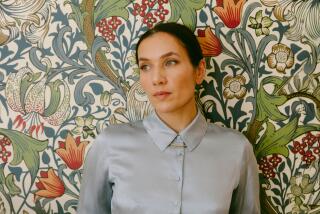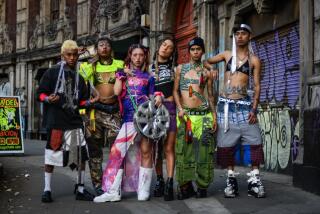Dressed-up diversity
- Share via
When costume designer Cynthia Summers was first approached about working on Showtime’s “The L Word,” she wasn’t interested. “I wasn’t sure how fun it would be to dress a bunch of butch girls,” she says. What she didn’t know was that she’d be costuming an L world of Gucci stilettos, Marc Jacobs miniskirts and white patent leather vintage Courreges jackets.
In the show, about a lesbian couple and their clique in Los Angeles, Jennifer Beals and her costars chat about clothes almost as much as Sarah Jessica Parker and hers do on “Sex and the City.” Clearly, Showtime hopes designer duds and stylish story lines will attract viewers, but with nary a Birkenstock or buzz cut in sight, “The L Word’s” feminized image of lesbians has left some wondering: Where are the dykes?
On the network’s online message board, one posting offered a list of things a “real lesbian show” would have, including “bi-level hairdos, hiking boots, baseball hats, polo shirts and at least one character who doesn’t shave her legs and armpits. These girls dress way too cute!”
The show’s fantasy lesbians are not the prevailing stereotype for heterosexuals either, according to Ann Ciasullo, who teaches gender studies and pop culture at the University of Oregon. Most people envision lesbians as butch dykes in sleeveless flannel shirts and jeans -- so how to represent lesbians on TV in a politically correct way becomes a quandary.
“Think about images of African Americans, and someone like Sidney Poitier, who was seen as changing the image of black men in film but by some critics was seen as an Uncle Tom figure,” Ciasullo says. “The same thing goes for lesbians. The stereotype is the butch lesbian, and to get away from that, you have the feminine lesbian. But as images get feminized, lesbianism gets subsumed.”
Issues of style are pertinent, because historically dress has been part of lesbian identity and used as an identifier, according to Frances Stevens, publisher of Curve magazine in San Francisco. Today lesbians wear anything and everything, though they still rely on “gaydar” to parse the visual clues that might answer the question: Is she or isn’t she? And judging from the first few episodes of “The L Word,” in which the virtues of tapered jeans with high heels, painted nails and a sundress on the first date are all discussed, the signs aren’t always clear. “We’re as diverse as the heterosexual community,” Stevens says.
Some in the lesbian community worry that “The L Word” and the publicity surrounding it will promulgate a new wave of lesbian chic that will only marginalize dykes. And instead of promoting acceptance, the show could be another case of lesbians being used as a marketing tool, this time to create a successor to “Sex and the City.”
L.A. sets the style
“The L Word” is filmed in Vancouver, Canada, where most of the costumes are procured. But the show’s creator, Ilene Chaiken, sent Summers to L.A. style meccas Maxfield, Agnes B., Chrome Hearts and the Beverly Center for wardrobe research.
“I think the show is more about L.A. than it is about lesbians,” says Heather Findlay, editor in chief of Girlfriends, one of the country’s largest lesbian magazines, based in San Francisco, with a monthly circulation of 30,000. Findlay notes that there are regional differences in style, and lesbians in L.A., generally speaking, are more femme, which means lipstick and heels, not Frye boots and flannel shirts.
“These women live in L.A.,” Chaiken says. “They approach the day in a looks-conscious way.”
Summers envisions Shane (Katherine Moennig) as a cross between Mick Jagger and Warren Beatty in “Shampoo,” in tank tops and custom-made leather pants so long that they that drag on the ground. Bette (Jennifer Beals) wears Gucci pinstripe suits with Prada, Pringle and Paul Smith men’s dress shirts tailored to fit her. “All the girls were kind of trying to find their inner lesbians,” Summers says.
Leisha Hailey, who plays Alice, a magazine editor -- and is the one actress on the show who is a lesbian in real life -- didn’t react kindly to all of the wardrobe suggestions. “I marched in and said, ‘Lesbians don’t wear purses!’ But now I’ve come to realize that’s not true, and I’ve come to wear one myself.”
Like most TV shows, “The L Word” represents only a microcosm of the world it depicts. But as the first show to portray the lesbian lifestyle, its hair, makeup and wardrobe choices carry more weight than usual.
“Masculinity looks really sexy on some women. It’s called butch,” says Karen Everett, who produced the documentary “Framing Lesbian Fashion” in 1992. “What’s missing from ‘The L Word’ is the ‘B word.’ That’s not to say the show isn’t reflective of middle-class lesbian fashions in L.A. But unfortunately, because there’s so little lesbian visibility on television, many viewers may think that the cast is reflective of lesbian dress codes and sensibilities nationwide, and that’s just not true.”
A personal statement
As it has for all women, fashion has at times been a means of political expression for lesbians. In underground gay bars in the early 20th century, wearing at least two articles of women’s clothing could spare one from being arrested in a raid, according to LesbianHerstory Archives.org. Lesbians in mid-20th century England and France, including Radclyffe Hall, author of the pathbreaking 1928 novel “The Well of Loneliness,” favored upper-class male dress, says fashion historian Valerie Steele. Hall wrote about a butch-femme relationship in her book, but it wasn’t until the 1950s, Steele says, that lesbian couples in the United States began adopting the look.
By the late 1960s, with the advent of the feminist movement, lesbians were showing their solidarity by wearing an androgynous uniform of jeans and flannel shirts, according to Everett’s film. In the late 1980s, “lipstick lesbians” traded the uniform for an erotic glamour created not for men but for other women, causing a stir among some who saw it as capitulation to the heterosexual hegemony. Steele notes that lipstick lesbianism was also part of a larger fashion movement, as women returned to wearing skirts and dresses, realizing that feminine style was not incompatible with feminism.
Vogue magazine dubbed lesbians the “hula hoops of the 1990s,” which to some implied that they were a novelty to be exploited for their sex appeal. Girl-on-girl ads for Banana Republic, Versace, Gucci and Christian Dior competed for the attention of the buying public -- both men and women. On a famous Vanity Fair cover in 1993, Cindy Crawford gave k.d. lang a shave.
The late Helmut Newton and other fashion photographers made careers of male fantasies of what lesbians look like (long legs, slicked-back hair, lacquered red lips, black leather corsets). In October, designers Viktor & Rolf, John Galliano for Dior, and Tom Ford for Yves Saint Laurent paid homage to Marlene Dietrich, who perfected the “garcon” look in Paris in the 1930s.
Today, lesbians on TV are no less glamorized.
“It’s not that the images are bad,” Ciasullo says. “Positive representations are important. But these representations of normal are bound by the expectation of femininity. You wouldn’t see a stereotypical butch woman anywhere on TV that would be anything but threatening.”
Sara Warn, editor of AfterEllen.com, a website devoted to lesbians and bisexuals on TV, says that “from a marketing perspective, there is no way ‘The L Word’ could have been accurate and been a success. They have to appeal to a wider audience, which means they had to pick the most conventionally attractive characters. They need more than lesbian and bisexual viewers. This show is subject to the same conventions as all of U.S. television.”
Raising the bar
Portraying lesbians at all on television is relatively new. The first lesbian kiss on a network was between C.J. Lamb (Amanda Donohoe) and Abby (Michele Greene) on “L.A. Law” in 1991. They both wore power suits and later said they regretted the scene, which they felt was designed to boost ratings. “Ellen” was the first sitcom to revolve around a lesbian character, although it took her four seasons to come out.
The first lesbian sex scene on a network did not appear until 2003, when Willow (Alyson Hannigan) discovered both her Wiccan powers and her attraction to Tara (Amber Benson) on “Buffy the Vampire Slayer.” Recurring lesbian characters on network TV now include Dr. Kerry Weaver on “ER” (in a lab coat, turtleneck, no makeup and a ponytail) and Bianca Kane on ABC’s “All My Children.” It’s also common to see faux lesbianism used for shock value -- as in the Madonna-Britney-Christina kiss.
“Once you get a taste,” Warn says, “it’s hard not to want more accuracy and representation. Do I expect a few years from now to hold ‘The L Word’ up to a higher standard and to have a butch lesbian in a recurring role? Yes.”
Judging from online postings, “L Word” viewers don’t find the characters inaccurate, just incomplete. “Lots of lesbians are clothes hounds,” Warn says. “Why wouldn’t they be? You are surrounded by women all the time and you are marketing yourself to women.”
For Summers, the costume designer, that’s encouraging. “I think eventually we do want to make this a fashion show that people tune in to to see what Shane is wearing,” she says.
So far, she’s been getting mixed reactions from design houses, even though the finale of “Sex and the City” this month will leave viewers starved for fashion and though lesbians have roughly $200 billion in buying clout, according to Women’s Wear Daily. Dolce & Gabbana hasn’t been that receptive, she says, but others have. “We called a local skateboarding label to ask for some jeans and explained that we were from a show about lesbians in L.A.,” Summers says. “They were totally into it. They said, ‘Cool!’ ”







